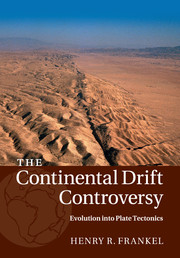Refine search
Actions for selected content:
10306 results in History of science: general interest
Conclusion: The Persistent Patterns!
-
- Book:
- Gender and Science
- Published by:
- Foundation Books
- Published online:
- 05 May 2013
- Print publication:
- 01 July 2012, pp 293-300
-
- Chapter
- Export citation
List of Contributors
-
- Book:
- Gender and Science
- Published by:
- Foundation Books
- Published online:
- 05 May 2013
- Print publication:
- 01 July 2012, pp ix-xii
-
- Chapter
- Export citation
10 - Demographic Inertia and the Glass Ceiling in American Science (1979–2000)
- from Section II - Illustrative Examples
-
-
- Book:
- Gender and Science
- Published by:
- Foundation Books
- Published online:
- 05 May 2013
- Print publication:
- 01 July 2012, pp 208-226
-
- Chapter
- Export citation
Contents
-
- Book:
- Gender and Science
- Published by:
- Foundation Books
- Published online:
- 05 May 2013
- Print publication:
- 01 July 2012, pp vii-viii
-
- Chapter
- Export citation
4 - Gender, Science, and the Psychology of Science
- from Section I - Approaches and Perspectives
-
-
- Book:
- Gender and Science
- Published by:
- Foundation Books
- Published online:
- 05 May 2013
- Print publication:
- 01 July 2012, pp 61-75
-
- Chapter
- Export citation
5 - Women and Minorities in Science: Discrimination and the Solution
- from Section I - Approaches and Perspectives
-
-
- Book:
- Gender and Science
- Published by:
- Foundation Books
- Published online:
- 05 May 2013
- Print publication:
- 01 July 2012, pp 76-92
-
- Chapter
- Export citation
6 - Women and Science in the Netherlands: A Dutch Case
- from Section II - Illustrative Examples
-
-
- Book:
- Gender and Science
- Published by:
- Foundation Books
- Published online:
- 05 May 2013
- Print publication:
- 01 July 2012, pp 95-149
-
- Chapter
- Export citation
3 - Gender and Technology
- from Section I - Approaches and Perspectives
-
-
- Book:
- Gender and Science
- Published by:
- Foundation Books
- Published online:
- 05 May 2013
- Print publication:
- 01 July 2012, pp 37-60
-
- Chapter
- Export citation
2 - Gender Imbalance in Science: Cultural Similarities and Diferences
- from Section I - Approaches and Perspectives
-
- Book:
- Gender and Science
- Published by:
- Foundation Books
- Published online:
- 05 May 2013
- Print publication:
- 01 July 2012, pp 20-36
-
- Chapter
- Export citation
1 - Getting More Women into Science: Knowledge Issues
- from Section I - Approaches and Perspectives
-
-
- Book:
- Gender and Science
- Published by:
- Foundation Books
- Published online:
- 05 May 2013
- Print publication:
- 01 July 2012, pp 3-19
-
- Chapter
- Export citation
Section I - Approaches and Perspectives
-
- Book:
- Gender and Science
- Published by:
- Foundation Books
- Published online:
- 05 May 2013
- Print publication:
- 01 July 2012, pp 1-2
-
- Chapter
- Export citation
11 - Women in Science in France
- from Section II - Illustrative Examples
-
-
- Book:
- Gender and Science
- Published by:
- Foundation Books
- Published online:
- 05 May 2013
- Print publication:
- 01 July 2012, pp 227-263
-
- Chapter
- Export citation
Index
-
- Book:
- Gender and Science
- Published by:
- Foundation Books
- Published online:
- 05 May 2013
- Print publication:
- 01 July 2012, pp 319-323
-
- Chapter
- Export citation
Acknowledgements
-
- Book:
- Gender and Science
- Published by:
- Foundation Books
- Published online:
- 05 May 2013
- Print publication:
- 01 July 2012, pp xiii-xiv
-
- Chapter
- Export citation
9 - Changing the Facts: Gender Dimensions of the South African Public Science System
- from Section II - Illustrative Examples
-
-
- Book:
- Gender and Science
- Published by:
- Foundation Books
- Published online:
- 05 May 2013
- Print publication:
- 01 July 2012, pp 185-207
-
- Chapter
- Export citation
Bibliography
-
- Book:
- Gender and Science
- Published by:
- Foundation Books
- Published online:
- 05 May 2013
- Print publication:
- 01 July 2012, pp 301-318
-
- Chapter
- Export citation
Fostering a new industry in the Industrial Revolution: Boulton & Watt and gaslight 1800–1812
-
- Journal:
- The British Journal for the History of Science / Volume 46 / Issue 2 / June 2013
- Published online by Cambridge University Press:
- 07 June 2012, pp. 199-229
- Print publication:
- June 2013
-
- Article
- Export citation
A Victorian extinction: Alfred Newton and the evolution of animal protection
-
- Journal:
- The British Journal for the History of Science / Volume 46 / Issue 4 / December 2013
- Published online by Cambridge University Press:
- 07 June 2012, pp. 695-714
- Print publication:
- December 2013
-
- Article
- Export citation

The Continental Drift Controversy
-
- Published online:
- 05 June 2012
- Print publication:
- 26 April 2012

Discovering Cell Mechanisms
- The Creation of Modern Cell Biology
-
- Published online:
- 05 June 2012
- Print publication:
- 10 October 2005
